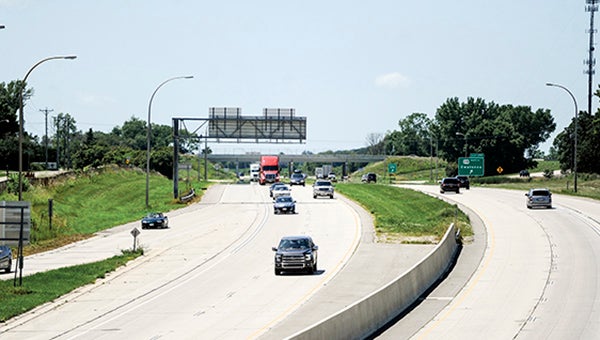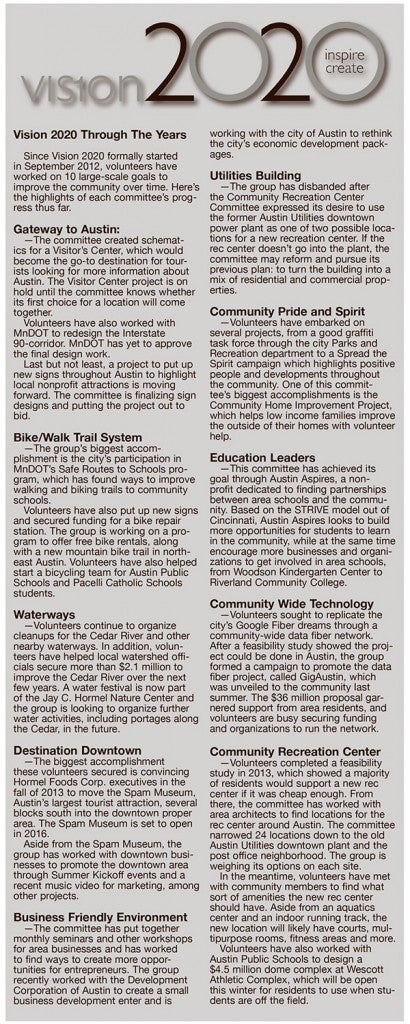In for the long haul; Vision 2020 looking past deadline to improve Austin
Published 1:01 pm Sunday, July 19, 2015

Vehicles made for a busy afternoon between Fourth Street and 14th Street Northwest Friday. The Vision 2020 initiative Gateway to Austin likely won’t be finished until after 2020. Eric Johnson/photodesk@austindailyherald.com
The city of Austin has watched over the past few years as hundreds of volunteers worked on numerous projects to improve the city. Those volunteers, working under the Vision 2020 initiative, have created new opportunities for community growth, from increased bicycle and walking trails to plans for better Internet.
Yet Vision 2020 will soon focus more on its longterm impact than accomplishing individual goals. Volunteer efforts are slowly but surely revealing changes within the community that will continue long past the group’s supposed end date.
“There’s nothing magic about the year 2020,” Laura Helle, Vision 2020’s director of vision creation, said. “That was the date that we set so that we had a deadline.”
As Vision 2020 projects continue moving forward, the changes Helle and other area leaders have preached are coming closer to fruition. Though some projects may continue past Vision 2020’s deadline, those volunteer efforts are creating systemic community change Vision 2020 had planned on all along.
“Several of the visions are really talking about culture change,” Helle said. “Business Friendly Environment, Community Pride and Spirit, Education Leaders, all of those things are part of our culture and just by definition … those are going to be more long term and ongoing.”
Community work
Several groups are already looking past the year 2020.
As John Gray put it, the biggest reasons why Vision 2020 Gateway to Austin Committee volunteers couldn’t move forward with their goals was because of bureaucratic scheduling outside of their control.
The committee’s chairman told the Austin City Council earlier this month he and other volunteers were pleased to move forward with a sign project throughout Austin after two major projects have been put on hold.
The committee hoped to move forward on redesigning the bridges over Austin’s Interstate 90 corridor, but the Minnesota Department of Transportation pushed projects to replace most of those bridges back until 2021, at the earliest.
“Really, we’re at a standstill,” Gray said Friday. “We’re at the liberty of MnDOT.”
In addition, volunteers are waiting to see what will happen with the Oak Park Mall site after negotiations between the city of Austin, Hy-Vee, and several mall businesses broke down this spring. If Hy-Vee decides to suspend its renovation plans and move on the Oak Park Mall site, Vision 2020 hopes to take part of the current Hy-Vee building for its planned Visitor Center.
There’s no word on whether Hy-Vee is still entertaining investing in the mall site. Hy-Vee spokespeople said last month the Austin store renovation hadn’t yet been scheduled.
In other words, both projects are at a standstill.
Though the Gateway to Austin Committee is the clearest example of a group that’ll accomplish it’s goals after 2020, there are plenty of projects which have already become successful.
The Community Pride and Spirit Committee has put together several successful projects, from a positive compliment campaign to volunteer efforts to clean up the city’s graffiti. Yet one of the biggest projects thus far has been the Community Home Improvement Program (CHIP), where volunteers work on smaller home improvement projects for low-income housing.
 The project, which started in 2013, drew several area organizations together to help. Among those groups was the Freeborn/Mower Habitat for Humanity, which technically took over the CHIP program last year.
The project, which started in 2013, drew several area organizations together to help. Among those groups was the Freeborn/Mower Habitat for Humanity, which technically took over the CHIP program last year.
“It allowed us to reach more families in need,” Brigitte Campbell, executive director of Habitat for Humanity, said. “Through CHIP, we have access to more volunteers, we have more support from the HRA and Vision 2020, and we’re more visible in the community.”
As Campbell puts it, the CHIP program aligned nicely with Habitat’s A Brush of Kindness program, which does similar exterior improvement housework for families in need.
With CHIP came resources and partnerships for Habitat, which quadrupled its volunteer pool as a result. In addition, grant money for the CHIP program has allowed Habitat to hire a community development coordinator, who oversees CHIP and other projects to help the community.
Habitat is on course to serve 35 households this year, including 24 CHIP projects this summer.
“We were already doing that kind of work anyway, and it provided us with access to more resources that we needed to serve more families,” Campbell said.
The Education Leaders Committee has, in effect, disbanded after the group put in place Austin Aspires, the nonprofit dedicated to building partnerships between schools and the community.
Jennifer Lawhead, the executive director, was hired last summer and has conducted research throughout the community on educational goals and expectations. She will reveal the results of her surveys later this month.
Moving into the future
As Austin moves closer to Vision 2020, volunteers are preparing to talk more about their projects.
Helle was hired in 2012 to oversee committee progress and look for grant opportunities. Yet the community’s desire for more information about Vision 2020 has caused Helle to spend more time on communication.
“We know people are curious about Vision 2020 and about the projects,” she said.
Effectively showing sweeping change to the community can be difficult, however.
Vision 2020 projects have ranged from a new community center and a community-wide broadband initiative to supporting the Peer Power Partners program between general and special education students at I.J. Holton Intermediate School, or coordinating a trip for elementary students to visit senior homes for Valentine’s Day.
Given how huge Vision 2020’s reach has become throughout the community, some projects can escape the public’s eye.
Yet Vision 2020 is actively seeking more ways to let the community know about their progress. Volunteers are polling a fifth of Austin’s population to see what people think of Vision 2020 and to ask how people get their news about volunteer projects.
In addition, Helle and other volunteers encourage residents to get more involved in the committees, which meet monthly.
As volunteers continue to work on projects, more change comes to Austin. Vision 2020 efforts will build over the next few years as high profile projects like the community recreation center and a large-scale data fiber network come to fruition. Yet the way Austin works will continue to change as Vision 2020 works to improve the community.
“We’re still working to create that change in Austin,” Helle said.

